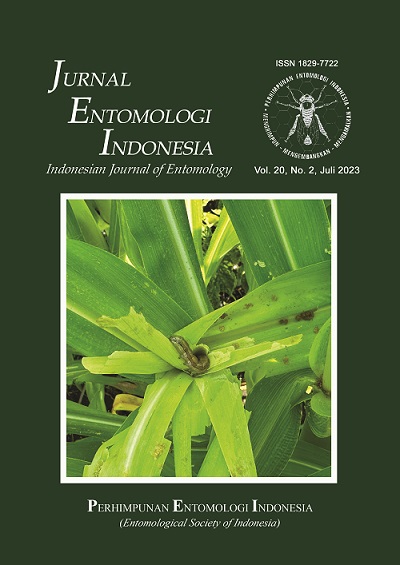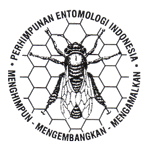The polymorphism of vespid wasps (Hymenoptera: Vespidae) from Indonesia with morphology-based cladistic
Polimorfisme tawon vespid (Hymenoptera: Vespidae) asal Indonesia dengan morfologi berbasis cladistic
DOI:
https://doi.org/10.5994/jei.20.2.101Keywords:
aposematism, biogeographical distribution, marking patternAbstract
Wasps in the family of Vespidae often have a yellowish black color with white or brown markings, but some species have variations in their markings and coloring. There is limited information available about the distribution of these marking patterns within the Vespidae Family. To clarify their taxonomic status, this study aims to examine the marking patterns of Vespid wasps that are widely distributed in the Indonesian Archipelago and to explore correlations with their biogeographical distribution patterns. In this study, specimens from three different locations (Bandung, Sumedang, and Purworejo) and specimens from the Museum Zoologicum Bogoriense (MZB) were examined. A total of 31 individuals from five different species were analyzed based on their morphological features. The data collected was coded and analyzed using cladistic methods, and the results were used to create cladogram trees for each of the five species i.e., Phimenes flavopictus, Polistes stigma, Apodynerus troglodytes, Vespa affinis, and Vespa velutina, showing their biogeographical distribution. The cladistic analysis in this study showed the relationships between the different species based on their morphological characteristics. The arrangements of the clades were determined using the Euclidean method in R studio. The results showed that P. flavopictus has two clades based on the marking patterns on their thorax and abdomen, while the other species i.e., Po. stigma, V. affinis, V. velutina, and A. troglodytes have three clades based on their coloring and marking patterns on all segments. The distribution of the Vespidae species appears to be scattered, with their patterns randomly distributed among locations.
Downloads
References
Blackith RE. 1958. An analysis of polymorphism in social Wasps. Insectes Sociaux. 5:263–272. DOI: https://doi.org/10.1007/BF02223936.
Calvert WH, Hedrick LE, Brower P. 1979. Mortality of the monarch butterfly (Danaus plexippus L.): avian predation at five overwintering sites in Mexico. Science. 204:847–51. DOI: https://doi.org/10.1126/science.204.4395.847.
Carpenter JM, Kojima J. 1997. Checklist of the species in the subfamily Vespinae (Insecta: Hymenoptera: Vespidae). Natural History Bulletin of Ibaraki University. 1:51–92.
Clapperton BK, Lo PL, Moller H, Sandlant GR. 1989. Variation in colour markings of German wasps Vespula germanica (F.) and common wasps Vespula vulgaris (L.) (Hymenoptera: Vespidae) in New Zealand. New Zealand Journal of Zoology. 16:303–313. DOI: https://doi.org/10.1080/03014223.1989.10422895.
Kumar, PG. 2013. A taxonomic revision of Phimenes Giordani Soika (Hymenoptera: Vespidae: Eumeninae) of Indian Subcontinent. Records of Zoological Survey of India. 113:119–135.
Handru A, Nugroho H, Fuki SM, Ubaidillah R, Kojima J. 2020. Eusocial wasp fauna of Sulawesi Island, the central island of Wallacea (Hymenoptera: Vespidae; Polistinae. Vespinae). Zootaxa. 4885:541–559. DOI: https://doi.org/10.11646/zootaxa.4885.4.5.
Hauglund K, Hage SB, Lampe HM. 2006. Responses of domestic chicks (Gallus gallus domesticus) to multimodal aposematic signals. Behavioral Ecology. 17:392–398. DOI: https://doi.org/10.1093/beheco/arj038.
Jeanne RL, Fagen RM. 1974. Polymorphism in Stelopolybia areata (Hymenoptera. Vespidae). Psyche. 81:155–166. DOI: https://doi.org/10.1155/1974/56479.
Jenner RA. 2004. Morphological phylogenetics in a molecular millennium. Systematic Biology. 53:333–342. DOI: https://doi.org/10.1080/10635150490423962.
Kornet, DJ, Turner H. 1999. Coding polymorphism for phylogeny reconstruction. Systematic Biology. 48:365–379. DOI: https://doi.org/10.1080/106351599260346.
Mallet J, Joron M. 1999. Evolution of diversity in warning color and mimicry: Polymorphisms, shifting balance, and speciation. Annual Review of Ecology and Systematics. 30:201–233. DOI: https://doi.org/10.1146/annurev.ecolsys.30.1.201.
Mora R, Hanson P. 2019. Widespread occurrence of black-orange black color pattern in Hymenoptera. Journal of Insect Science. 19:1–12. DOI: https://doi.org/10.1093/jisesa/iez021.
Nguyen L, Vu TT, Lee J, Carpenter J. 2017. Taxonomic notes on the Polistes stigma group (Hymenoptera. Vespidae: Polistinae) from continental Southeast Asia. with descriptions of three new species and a key to species. Raffles Bulletin of Zoology. 65:269–279.
Nugroho H, Lupiyaningdyah P, Kojima J. 2020. Review of the potter wasps (Hymenoptera: Vespidae. Eumeninae) with a petiolate metasoma from Indonesian Archipelago. BIO Web of Conferences. 19:1–12. DOI: https://doi.org/10.1051/bioconf/20201900005.
Perrard A, Arca M, Rome Q, Muller F, Tan J, Bista S, Nugroho H, Baudoin R, Baylac M, Silvain J, Carpenter J, Villemant C. 2014. Geographic variation of melanisation patterns in a hornet species: genetic differences. climatic pressures or aposematic constraints?. PloS one. 9:1–16. DOI: https://doi.org/10.1371/journal.pone.0094162.
Pfennig DW, Harcombe WR, Pfennig KS. 2001. Frequency-dependent Batesian mimicry: Predators avoid look-alikes of venomous snakes only when the real thing is around. Nature. 410:323. DOI: https://doi.org/10.1038/35066628.
Rokas A, Williams BL, King N, Carroll SB. 2003. Genomescale approaches to resolving incongru-ence in molecular phylogenies. Nature. 425:798–804. DOI: https://doi.org/10.1038/nature02053.
Scotland RW, Olmstead RG, Bennett JR. 2003. Phylogeny reconstruction: The role of morphology. Systematic Biology. 52:539–548. DOI: https://doi.org/10.1080/10635150309309.
True JR. 2003. Insect melanism: the molecules matter. Trends in Ecology & Evolution. 18:640–647. DOI: https://doi.org/10.1016/j.tree.2003.09.006.
Wiens, JJ. 2004. The role of morphological data in phylogeny reconstruction. Systematic Biology. 53:653–661. DOI: https://doi.org/10.1080/10635150490472959.
Wilson EO. 1953. The origin and evolution of polymorphism in ants. The Quarterly Review of Biology. 28:136–156. DOI: https://doi.org/10.1086/399512.
Wilson EO. 1971. The Insect Societies. Cambridge: Harvard University Press.
Published
How to Cite
Issue
Section
License
Copyright (c) 2023 Yelsha Ramadhila, Hari Nugroho, Erfanus Jane, Intan Ahmad

This work is licensed under a Creative Commons Attribution 4.0 International License.
Authors who publish with this journal agree to the following terms:
- Authors retain copyright and grant the journal right of first publication with the work simultaneously licensed under a Creative Commons Attribution 4.0 International License that allows others to share the work with an acknowledgement of the work's authorship and initial publication in this journal.
- Authors are able to enter into separate, additional contractual arrangements for the non-exclusive distribution of the journal's published version of the work (e.g., post it to an institutional repository or publish it in a book), with an acknowledgement of its initial publication in this journal.
- Authors are permitted and encouraged to post their work online (e.g., in institutional repositories or on their website) prior to and during the submission process, as it can lead to productive exchanges, as well as earlier and greater citation of published work (See The Effect of Open Access).








